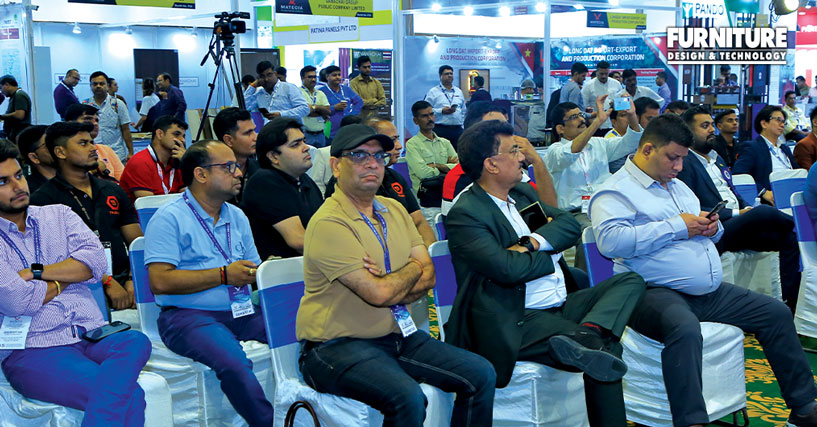
Mr Dwivedi further professed that design plays a pivotal role in shaping the industry’s future. In the world of furniture manufacturing, design thinking acts as a guiding light, ensuring that every facet of the business aligns seamlessly. It’s a concept so powerful that when design is done right, everything else naturally falls into place. In response Mr Alagh, was quick to add that for his company, it’s the raw materials that form the bedrock of quality control. He pointed out that it’s not just about obtaining raw materials but it’s about controlling the entire process, from planting to the selection of wood. The proactive approach, included large-scale plantation and meticulous quality checks, exemplifing the intricate level of control that can be achieved.
.jpg)
Furthermore, Mr Bhatia highlighted an essential transformation desired in the Make in India initiative within the furniture industry. “We believed that the industry would progress if manufacturers had easy access to readily available stocks of these trending décors and surfaces. These are the same materials used by manufacturers and producers who export furniture worldwide,” he confirmed. Drawing a basic comparison between the practices in the West and India, he added, “In the West, they treat research and development (R&D) as an investment, while we often view it as an expense. To achieve technologically advanced products in India, we must change our perception and recognize R&D as an investment.” Mr Sharda underlined the critical role that design, production and installation play in crafting quality furniture. He also stressed the need for a well-informed team that knows where and how to use different materials efficiently. This seamless coordination, he asserted, ensures that the end customer receives precisely what they envisioned, turning every piece into a work of art.
The challenge of edge banding was another complex issue that the panelists were keen to address during the panel discussion. In an era where new designs flood the market daily, manufacturers are grappling with the need to match countless colours and patterns. The solution to this design conundrum is the innovation in digital printing. Mr Garg aptly pointed out, in Europe, digital printing is already revolutionizing the industry. However, there’s a unique hurdle in the case of edge banding. “Digital printing has been used in the industry for some time, but, since edge banding is a small product in the form of a roll, unlike an 8x4 sheet, it has been challenging to print on. However, the practice of printing on a 22mm tape has now started in Europe. We are trying to introduce this technology in India, which would allow us to scan the customerprovided sample and resolve the issue of minimum order quantity (MOQ).”
Mr Bhatia shared his approach to tackle the problem of dead stock consisting of laminates and edge bands, where unsold materials clutter factories and disrupt efficiency. “We don’t just offer matching edge bands; we provide a MOQ of 10m to avoid dead stock. This is how we offer factories more flexibility and possibilities.”
.jpg)
Many designs are currently trending, and there’s a demand for uniqueness, novelty, and customization. Mr. Dwivedi piqued Mr. Ahmed’s interest in how new machinery could play a significant role in meeting this demand while ensuring efficiency and quality are maintained. Illustrating several advantages in this context, Mr Ahmed cited, “Firstly, mass production offers economic benefits, and standardization supports this. Secondly, there is a growing trend in the industry towards personalized products. Technology, particularly CNC machines, is making this possible. These machines are well-suited for producing single products or small batches.”
The intersection of innovation, customization and technology is propelling the furniture and modular kitchen industry to new heights. As the sector continuously reinvents itself, it’s the companies and experts who are willing to embrace change and adapt to the demands of a design-driven world who will lead the way. Similarly, edge banding is no longer just a challenge; it’s an opportunity to showcase the industry’s limitless potential.
The secrets of success in the furniture industry lie in a harmonious fusion of Manpower, Material, Machinery, and Method. But it’s the invisible Q word, Quality, driven by passion and nurtured as a culture, that truly sets the industry’s leaders apart. As these experts revealed, the world of furniture isn’t just about aesthetics; it’s about the devotion to craftsmanship and precision, resulting in pieces that will grace our homes for generations to come. As Mr Bhatia aptly concluded, “The art of making it to the top lies in a nurturing a collaboration. A competitive spirit might fuel the initial stages, but it’s the alliances and partnerships forged at the industry’s zenith that truly drive progress.”
This article is a part of our exclusive article ‘Managing Efficiency & Quality in the Furniture Industry’ which is originally published in Furniture Design & Technology (FDT Magazine) November 2023 print issue. If you want to read the full article, please subscribe Furniture Design & Technology Magazine here:
Furniture Design India and the magazine FURNITURE DESIGN & TECHNOLOGY (FDT magazine) are from the trusted 22-year-old media house of SURFACES REPORTER and PLY REPORTER.
FDT is a B2B monthly bilingual magazine from India that shares the pulse of the furniture business in India and connects the manufacturers, OEMS, product designers, architects, showrooms, designers and dealers.
Read More© 2025 Furniture Design and Technologies.. All Rights Reserved. Developed by eyeQ Advertising